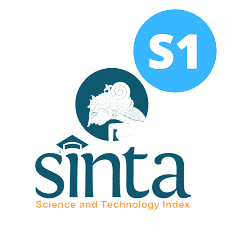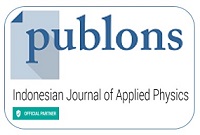Analysis of Vegetation Index Values and Sugar Content in Sugarcane Based on Planting Age using Sentinel-2 Satellite Data
Abstract
This study the relationship between the age of sugarcane plants (Saccharum officinarum L.), vegetation indices, and sugar content using Sentinel-2 satellite imagery in Jember Regency. Vegetation indices such as NDVI, GNDVI, NDRE, and NDII were used to monitor the physiological condition of the plants, while sugar content was measured using a refractometer on the upper, middle, and lower sections of the sugarcane stalks. The results indicate that the highest sugar content was found in the lower stalk section, as this area serves as the primary storage site for sucrose. There is relationship that increasing plant age correlates with changes in vegetation index patterns, peaking during the maximum vegetative phase. These findings offer significant insights into technology-based sugarcane land management, supporting the optimization of harvest timing, irrigation, and fertilization.
Keywords
Full Text:
PDFReferences
1 Putra, R. P. (2020). Perkecambahan dan Pertumbuhan Awal Budset Dan Budchip Tebu (Saccharum Officinarum L.) Yang Ditanam Pada Berbagai Posisi Mata Tunas. Jurnal Agrotek Tropika, 8(3), 435. https://doi.org/10.23960/jat.v8i3.3980
2 Singh, A., Lal, U. R., Mukhtar, H. M., Singh, P. S., Shah, G., & Dhawan, R. K. (2015). Phytochemical profile of sugarcane and its potential health aspects. Pharmacognosy Reviews, 9(17), 45. https://doi.org/10.4103/0973-7847.156340
3 Sulaiman, A. A., Sulaeman, Y., Mustikasari, N., Nursyamsi, D., & Syakir, A. M. (2019). Increasing sugar production in Indonesia through land suitability analysis and sugar mill restructuring. Land, 8(4), 1–17. https://doi.org/10.3390/land8040061
4 Apriawan, D. C., & Mulyo, J. H. (2015). Analysis of Sugarcane and Sugar Production in PT. Perkebunan Nusantara VII (PERSERO). Agro Ekonomi, 26(2), 159–167.
5 BPS. (2024). Impor Gula Menurut Negara Asal Utama Tahun 2017-2023. In Badan Pusat Statistik. https://www.bps.go.id/id/statistics-table/1/MjAxNCMx/impor-gula-menurut-negara-asal-utama--2017-2022.html
6 Afandi, F. A. (2024). Analisis Kebijakan Agribisnis Gula di Indonesia. Jurnal Pangan, 33(1), 81–88. https://doi.org/10.33964/jp.v33i1.636
7 Ustuner, M., Sanli, F. B., Abdikan, S., Esetlili, M. T., & Kurucu, Y. (2014). Crop type classification using vegetation indices of rapideye imagery. International Archives of the Photogrammetry, Remote Sensing and Spatial Information Sciences - ISPRS Archives, 40(7), 195–198. https://doi.org/10.5194/isprsarchives-XL-7-195-2014
8 Aji, S., Sukmono, A., & Amarrohman, F. J. (2020). Analisis Pemanfaatan Satellite Derived Bathymetry Citra Sentinel-2A Dengan Menggunakan Algoritma Lyzenga Dan Stumpf (Studi Kasus : Perairan Pelabuhan Malahayati, Provinsi Aceh). Jurnal Geodesi UNDIP, 10(1), 68–77. https://ejournal3.undip.ac.id/index.php/geodesi/article/view/ 29624
9 Clabaut, É., Foucher, S., Bouroubi, Y., & Germain, M. (2024). Synthetic Data for Sentinel-2 Semantic Segmentation. Remote Sensing, 16(5), 818. https://doi.org/10.3390/RS16050818
10 Aslan, M. F., Sabanci, K., & Aslan, B. (2024). Artificial Intelligence Techniques in Crop Yield Estimation Based on Sentinel-2 Data: A Comprehensive Survey. Sustainability (Switzerland), 16(18), 8277, https://doi.org/10.3390/su16188277
11 Cahyono, B. E., Rahagian, R., & Nugroho, A. T. (2023). Analisis Produktivitas Padi berdasarkan Indeks Kekeringan (NDWI dan NDDI) Lahan Sawah menggunakan Data Citra Sentinel-2A di Kecamatan Ambulu. Indonesian Journal of Applied Physics, 13(1), 88. https://doi.org/10.13057/ijap.v13i1.70682
12 Qader, S. H., Utazi, C. E., Priyatikanto, R., Najmaddin, P., Hama-Ali, E. O., Khwarahm, N. R., Tatem, A. J., & Dash, J. (2023). Exploring the use of Sentinel-2 datasets and environmental variables to model wheat crop yield in smallholder arid and semi-arid farming systems. Science of the Total Environment, 869, 161716. https://doi.org/10.1016/j.scitotenv.2023.161716
13 Rekha, B. U., Desai, V. V., Kuri, S., Ajawan, P. S., Jha, S. K., & Patil, V. C. (2025). Field-level sugarcane yield estimation utilizing Sentinel-2 time-series and machine learning. Indonesian Journal of Electrical Engineering and Computer Science, 37(1), 475–487. https://doi.org/10.11591/IJEECS.V37.I1.PP475-487
14 Taravat, A., Abebe, G., Gessesse, B., & Tadesse, T. (2024). Estimation Of Sugarcane Yield Using Multi-Temporal Sentinel 2 Satellite Imagery And Random Forest Regression. Remote Sensing and Spatial Information Sciences, XLVIII, 11–12.
15 Misto, Mulyono, T., Cahyono, B. E., & Zain, T. (2019). Determining sugar content in sugarcane plants using LED spectrophotometer. AIP Conference Proceedings, 2202. https://doi.org/10.1063/1.5141738
16 Liepa, A., Thiel, M., Taubenböck, H., Steffan-Dewenter, I., Abu, I. O., Singh Dhillon, M., Otte, I., Otim, M. H., Lutaakome, M., Meinhof, D., Martin, E. A., & Ullmann, T. (2024). Harmonized NDVI time-series from Landsat and Sentinel-2 reveal phenological patterns of diverse, small-scale cropping systems in East Africa. Remote Sensing Applications: Society and Environment, 35, 101230. https://doi.org/10.1016/J.RSASE.2024.101230
17 Morel, J., Bégué, A., Todoroff, P., Lebourgeois, V., & Petit, M. (2014). Coupling a sugarcane crop model with the remotely sensed time series of fIPAR to optimise the yield estimation. European journal of agronomy. 61, 60–68. https://doi.org/10.1016/j.eja.2014.08.004
18 Cahyono, B. E., Nugroho, A. T., & Wulandari, N. D. (2022). Analisis Usia Tebu Terhadap Pola Nilai GNDVI (Green Normalized Difference Vegetation Index) Berdasarkan Data Citra Landsat-8. Jurnal Teknotan, 16(3), 139. https://doi.org/10.24198/jt.vol16n3.2
19 Dengia, A., Dechassa, N., Wogi, L., & Amsalu, B. (2023). A simplified approach to satellite-based monitoring system of sugarcane plantation to manage yield decline at Wonji-Shoa Sugar Estate, central Ethiopia. Heliyon, 9(8), e18982. https://doi.org/10.1016/J.HELIYON.2023.E18982
20 Alemán-Montes, B., Zabala, A., Henríquez, C., & Serra, P. (2023). Modelling Two Sugarcane Agro-Industrial Yields Using Sentinel/Landsat Time-Series Data and Their Spatial Validation at Different Scales in Costa Rica. Remote Sensing, 15(23), 5476. https://doi.org/10.3390/RS15235476
21 Maia de Olivia, F. C., Bufon, V. B., & Leão, T. P. (2023). Vegetation indices as a Tool for Mapping Sugarcane Management Zones. Precision Agriculture, 24(1), 213–234. https://doi.org/10.1007/S11119-022-09939-7/FIGURES/13
22 Kaplan, G., & Avdan, U. (2017). Object-based water body extraction model using Sentinel-2 satellite imagery. European Journal of Remote Sensing, 50(1), 137–143. https://doi.org/10.1080/22797254.2017.1297540
23 Lasaiba, M. A., & Tetelepta, E. G. (2023). Analisis Spasial Kerapatan Vegetasi Kota Ambon Berbasis Normalized Difference Vegetation Index (Ndvi). Jurnal Pengembangan Kota, 11(2), 124–139. https://doi.org/10.14710/jpk.11.2.124-139
24 Haryayudhanto, M. R., Habibie, M. I., Sari, D. A. K., Aryaguna, P. A., & Suryandari, R. Y. (2022). Green Open Space Assessment Using Vegetation Index Analysis (Case study: North Bekasi District). Asia-Pacific Conference on Geoscience, Electronics and Remote Sensing Technology (AGERS), 94–98. https://doi.org/10.1109/AGERS56232. 2022.10093665
25 Boiarskii, B. (2019). Comparison of NDVI and NDRE Indices to Detect Differences in Vegetation and Chlorophyll Content. Journal of Mechanics of Continua and Mathematical Sciences, SpI 1(4). 20-29, https://doi.org/10.26782/jmcms.spl.4/ 2019.11.00003
26 Zhou, H., Zhou, G., Song, X., & He, Q. (2022). Dynamic Characteristics of Canopy and Vegetation Water Content during an Entire Maize Growing Season in Relation to Spectral-Based Indices. Remote Sensing, 14(3). 584, https://doi.org/10.3390/rs 14030584
27 Jamnani, R, M., Liaghat, A., & Mirzaei, F. (2019). Optimization of sugarcane harvest using remote sensing. International Archives of the Photogrammetry, Remote Sensing and Spatial Information Sciences - ISPRS Archives, 42(4/W18), 857–861. https://doi.org/10.5194/isprs-archives-XLII-4-W18-857-2019
28 Susantoro, T. M., Wikantika, K., Harto, A. B., & Suwardi, D. (2019). Monitoring Sugarcane Growth Phases Based on Satellite Image Analysis (A Case Study in Indramayu and its Surrounding, West Java, Indonesia). HAYATI Journal of Biosciences, 26(3), 117–117. https://doi.org/10.4308/HJB.26.3.117
29 Wang, J., Zhao, T., Yang, B., & Zhang, S. (2017). Sucrose Metabolism and Regulation in Sugarcane. Journal of Plant Physiology & Pathology, 05(04). https://doi.org/10.4172/2329-955x.1000167
30 Dimov, D., Uhl, J. H., Löw, F., & Seboka, G. N. (2022). Sugarcane yield estimation through remote sensing time series and phenology metrics. Smart Agricultural Technology, 2, 100046. https://doi.org/10.1016/j.atech.2022.100046
31 Akbarian, S., Xu, C. Y., & Lim, S. (2020). Analysis On The Effect Of Spatial And Spectral Resolution Of Different Remote Sensing Data In Sugarcane Crop Yield Study. ISPRS Annals of the Photogrammetry, Remote Sensing and Spatial Information Sciences, 3, 655–661. https://doi.org/10.5194/ISPRS-ANNALS-V-3-2020-655-2020
32 Canata, T. F., Wei, M. C. F., Maldaner, L. F., & Molin, J. P. (2021). Sugarcane yield mapping using high-resolution imagery data and machine learning technique. Remote Sensing, 13(2), 1–14. https://doi.org/10.3390/rs13020232
33 Barbosa, F. da S., Coelho, R. D., Barros, T. H. da S., Lizcano, J. V., Fraga Júnior, E. F., Santos, L. da C., Leal, D. P. V., Ribeiro, N. L., & Costa, J. de O. (2024). Sugarcane Water Productivity for Bioethanol, Sugar and Biomass under Deficit Irrigation. AgriEngineering, 6(2), 1117–1132, https://doi.org/10.3390/AGRIENGINEERING 6020064
Refbacks
- There are currently no refbacks.
















